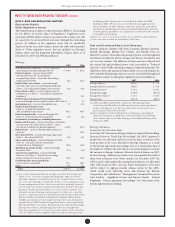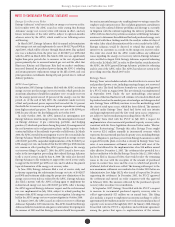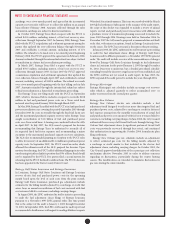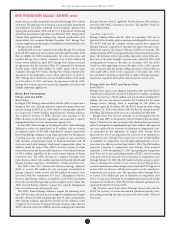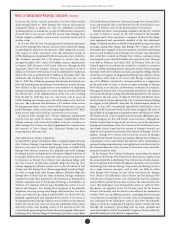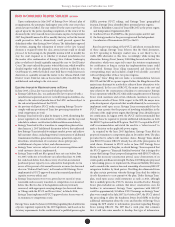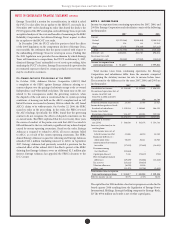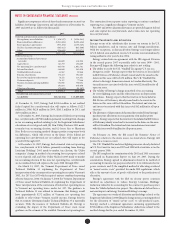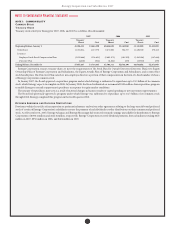Entergy 2007 Annual Report Download - page 75
Download and view the complete annual report
Please find page 75 of the 2007 Entergy annual report below. You can navigate through the pages in the report by either clicking on the pages listed below, or by using the keyword search tool below to find specific information within the annual report.
73
Entergy Corporation and Subsidiaries 2007
Notes to Consolidated Financial Statements continued
Upon conrmation in May 2007 of Entergy New Orleans’ plan of
reorganization, the automatic bankruptcy stay of the state court class
action lawsuit was lied. e stay ordered by the state court that was
agreed upon by the parties (pending completion of the review of the
decision by the City Council), however, remains in place. In September
2007 the plaintis moved to li or modify that stay so that the lawsuit
could proceed in full or, alternatively, could proceed against the
defendants other than Entergy New Orleans. e defendants opposed
the motion, arguing that exhaustion of review of the City Council
decision is required before the class action lawsuit could or should
proceed. At the hearing on the plaintis’ motion to li or modify the
stay, the court inquired as to whether it retained jurisdiction over
the matter aer conrmation of Entergy New Orleans’ bankruptcy
plan or whether it should equitably remand the case to Civil District
Court. e court ordered the parties to brief this issue, which would be
decided together with the plaintis’ motion to li or modify the stay.
On February 13, 2008, the federal court held that it would exercise its
discretion to equitably remand the matter to the Orleans Parish Civil
District Court. It did not rule on the motion to li or modify the stay
and deferred such ruling to the state court.
EL E C T R I C IN D U S T R Y RE S T R U C T U R I N G IN T E X A S
In June 2005, a Texas law was enacted which provides that:
n Entergy Gulf States, Inc. was authorized by law to proceed with a
jurisdictional separation into two vertically integrated utilities, one
subject to the sole retail jurisdiction of the LPSC and one subject to
the sole retail jurisdiction of the PUCT;
n the portions of all prior PUCT orders requiring Entergy Texas to
comply with any provisions of Texas law governing transition to
retail competition are void;
n Entergy Texas had to le a plan by January 1, 2006, identifying the
power region(s) to be considered for certication and the steps and
schedule to achieve certication (additional discussion below);
n Entergy Texas had to le a transition to competition plan no later
than January 1, 2007 (additional discussion below), that addressed
how Entergy Texas intended to mitigate market power and achieve
full customer choice, including potential construction of additional
transmission facilities, generation auctions, generation capacity
divestiture, reinstatement of a customer choice pilot project,
establishment of a price to beat, and other measures;
n Entergy Texas’ rates are subject to cost-of-service regulation until
retail customer choice is implemented;
n Entergy Texas could not le a general base rate case before June
30, 2007, with rates to be eective no earlier than June 30, 2008,
but could seek before then the recovery of certain incremental
purchased power capacity costs, adjusted for load growth, not in
excess of ve percent of its annual base rate revenues (as discussed
above in “Deferred Fuel Costs,” in December 2005 Entergy Texas
implemented a PUCT-approved annual incremental purchased
capacity recovery rider); and
n Entergy Texas may recover over a period not to exceed 15 years
reasonable and necessary transition to competition costs incurred
before the eective date of the legislation and not previously
recovered, with appropriate carrying charges (as discussed above
in “Filings with the PUCT and Texas Cities,” in March 2006,
Entergy Texas implemented PUCT-approved rates for recovery of
its transition to competition costs).
Entergy Texas made the January 2006 ling regarding the identication
of power region(s) required by the 2005 legislation, and based on the
statutory requirements for the certication of a qualied power region
(QPR), previous PUCT rulings, and Entergy Texas’ geographical
location, Entergy Texas identied three potential power regions:
1) Electric Reliability Council of Texas (ERCOT) as the power region
and Independent Organization (IO);
2) Southwest Power Pool (SPP) as the power region and IO; and
3) the Entergy market as the power region and the Independent
Coordinator of Transmission (ICT) as the IO.
Based on previous rulings of the PUCT, and absent reconsideration
of those rulings, Entergy Texas believes that the third alternative,
an ICT operating in Entergy’s market area, is not likely to be a
viable QPR alternative at this time. Accordingly, while noting this
alternative, Entergy Texas’ January 2006 ling focused on the rst two
alternatives, which were expected to meet the statutory requirements
for certication so long as certain key implementation issues could
be resolved. Entergy Texas’ ling enumerated and discussed the
corresponding steps and included a high-level schedule associated
with certifying either of these two power regions.
Entergy Texas’ ling did not make a recommendation between
ERCOT and the SPP as a power region. Rather, the ling discussed the
major issues that must be resolved for either of those alternatives to be
implemented. In the case of ERCOT, the major issue is the cost and
time related to the construction of facilities to interconnect Entergy
Texas’ operations with ERCOT, while addressing the interest of Entergy
Texas’ retail customers and certain wholesale customers in access to
generation outside of Texas. With respect to the SPP, the major issue
is the development of protocols that would ultimately be necessary to
implement retail open access. Entergy Texas recommended that the
PUCT open a project for the purpose of involving stakeholders in the
selection of the single power region that Entergy Texas should request
for certication. In August 2006, the PUCT sta recommended that
Entergy Texas be required to provide additional information on both
the ERCOT option and the SPP option. e PUCT accepted the PUCT
sta’s recommendation and stated the need for a “robust record” to
make a decision on the applicable power region.
As required by the June 2005 legislation, Entergy Texas led its
proposed transition to competition plan in December 2006. e plan
provides that to achieve full customer choice, Entergy Texas should
join ERCOT because ERCOT already has all of the prerequisites for
retail choice. Pursuant to PUCT order, in June 2007 Entergy Texas
led a restatement of the plan, in which Entergy Texas requested that
the PUCT approve a “Financial Stability Provision” that is designed to
ensure that Entergy Texas’ proposed integration with ERCOT will not,
during the necessary construction period, cause deterioration of its
credit quality and nancial strength. e June 2007 ling also proposed
a rule making process to implement the Financial Stability Provision
and to consider the construction and ownership of necessary ERCOT
integration facilities by third parties. e ling also eliminated from
the plan certain provisions whereby Entergy Texas had the ability in
its sole discretion to cease pursuit of the plan. Under Entergy Texas’
plan, retail open access could commence as early as 2013, although
that is unlikely given the PUCT’s decision described below. Entergy
Texas’ plan included an estimate that direct construction costs for
facilities to interconnect Entergy Texas’ operations with ERCOT
could be approximately $1 billion. PUCT hearings on Entergy Texas’
plan were completed in July 2007. In October 2007, the PUCT abated
the proceeding to allow the Southwest Power Pool (SPP) to develop
additional information about the costs and benets of Entergy Texas
joining the SPP similar to information presented regarding Entergy
Texas joining ERCOT. e SPP led a work plan that estimates
that it will take nine months to develop this type of information.




